FREED LIVES IN MEMORIES OF OLD TIMERS - Most Famous Citizen Died In 1845, New Old Leading Creek Tales
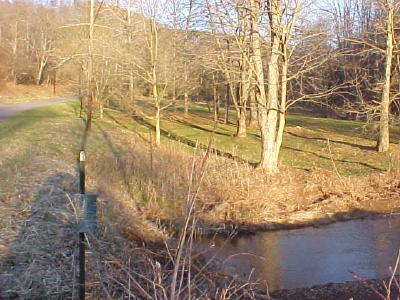
It was here the bustling Village of Freed once stood
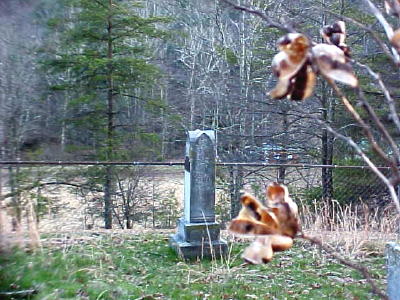
The resting place of historic figure Phebe Cunningham,
just above the Leading Creek Road
By Bob Weaver 2001
Imagination and recollection of a few old timers is needed to remember the Village of Freed, which once rested on a grassy bottom beside Leading Creek at the mouth of Coal Fork.
Freed's most notable memories are connected with a historic citizen who has reposed in the nearby Gainer-Shimer Cemetery since 1845 and a 1933 fire that wiped away much of the hamlet.
Besides the Freed, Gainer-Shimer and Saunders Cemeteries, there are a few worn buildings recalling Freed's past, including the one-room Bell School, a tiny post office, a few old dwellings and the Hoy Chapel Church.
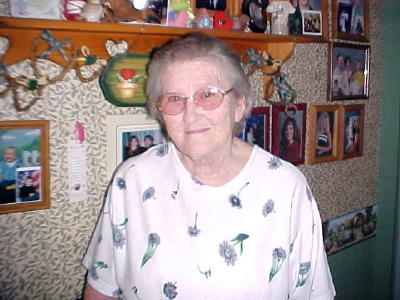
Hazel Veon Snider "I've had a great life here,
talked, laughed and had a good time"
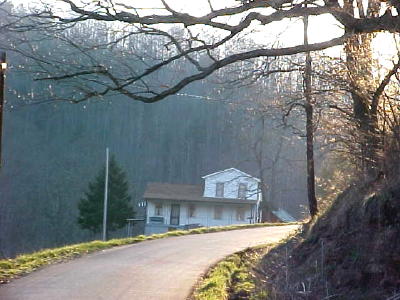
113-year-old Snider homestead at Freed, beside Leading Creek Road
Hazel Snider, 79, (now deceased) recalls many of the old-timers in the community, including John Snider, great-grandfather of her late husband Willard. She still lives in the 113 year old house built by Snider, and later occupied by his son, her father-in-law, Rev. Jacob Snider (1878-1959) who was a United Brethren minister in Calhoun. Jacob was married to Viola Shimer, another well-known name in the community.
Hazel and Willard have six children, most of them still living in the community. "They all come to my house for every holiday. It's quite a bunch, about forty," said Mrs. Snider, who maintains a warm and well-kept country home.
She recalls uncle Ben Shimer's store and adjacent two-story house which was spared by the 1933 fire. "Not far away was the post office which was run by Ivy Collins," she said. "All my kids went to the one-room Bell school. Bessie Collins was a teacher there."
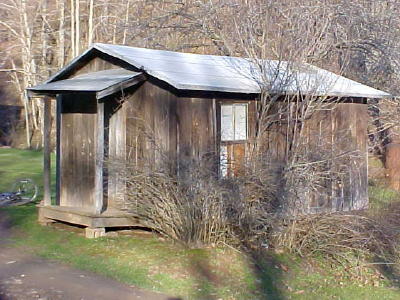
The tiny Freed Post Office has been closed for years, and has now been moved the historic village at Calhoun Park
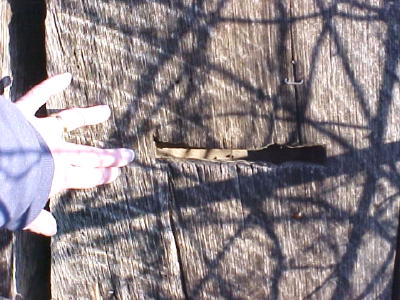
A mail slot was cut through the rough boards for "night deposits"
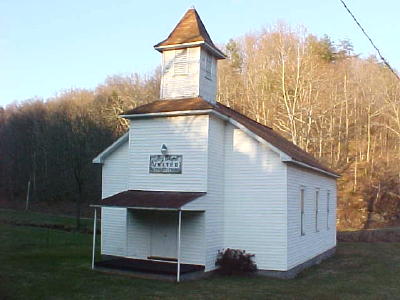
Hoy Chapel United Methodist Church still being used, established 1900
Mrs. Snider said the still-standing Hoy Chapel Church was established in 1900, saying the Pine Grove church washed away.
"I thought it was a great place. Everyone was friendly. I've had a great life here, talked, laughed and had a good time," she concluded. "My husband and I never even had a serious fight. Think about that."

Oleta Collins Cunningham Kelley
"I traded eggs for candy at Shimer's store"
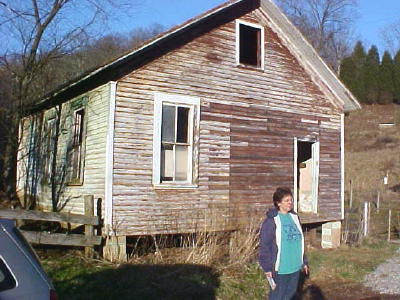
The one-room Bell School, long closed, is still standing,
Patty Collins Cain shown in front of structure
Oleta Collins Cunningham Kelley, now 81, said "People complain about the blacktop road through Freed, but they should have a dose of the muddy dirt road and deep ditches, not too many years ago.
"I guess life was pretty quiet, we'd play ball and I went to 4-H," she said.
Mrs. Kelley, who was selected as a Calhoun Belle a few years ago, is the daughter of Allie G. and Pearl Holbert Collins. She now lives at Beech Valley, not far from Big Springs.
"I used to take eggs down to Ben Shimer's store and get a poke of candy," she said. "Traveling up and down that muddy road at night going to church was an experience." She remembered educator Troea Morrison teaching at the Freed School, saying the Morrison's also had a country store.
She said about all her family would purchase at the store was baking soda, salt, pepper, coffee and sugar - "The rest we raised."
Freed's famous citizen is Phebe (sometimes spelled Phebe) Tucker Cunningham, wife of Revolutionary War soldier Thomas Cunningham. She was a pioneer woman who endured tragedy and sacrifice, having been captured by Indians. Phebe came to Freed to live with her daughter, where she passed away.
Historian Norma Knotts Shaffer says more people than you can imagine have used their heritage to Cunningham to become Daughters of the American Revolution, with a Grantsville chapter named after Phebe.
The account of the life of Thomas and Phebe Tucker Cunningham is well-chronicled in Alexander Scott Withers' history "Chronicles of Border Warfare," first published in 1895.
In 1785 six Indians came to their cabin along the West Fork River (Harrison County) and entered Cunningham's cabin while he was away.
Phebe tried to protect her four children, but one of the Indians "raised his tomahawk and sunk it deep into the brains of one of the children (two-year-old Walter), throwing the body into the backyard, ordering Phebe to follow after them."
Phebe, taking her two other children with an infant clinging to her breast, followed the orders, as the Indian scalped the lifeless body of her child reposing in the yard. The Indians then set fire to her house, burning it to the ground.
The Indians then sunk the hatchet into her eldest son, then her little daughter "whom they then took by the arms and legs, slinging it repeatedly against a tree, ending its suffering." They then secured their third scalp.
Phebe then expected to he slain with her infant, but the Indians took them into captivity.
Later, the infant needing its mother's milk cried with discontent, said Withers, but could only extract blood from the malnourished woman. Phebe said the Indians, not wanting the noise of the crying baby, ended its life while it was still trying to nurse.
She recalled that in ten days she ate the head of a wild turkey and three paw paws.
After three years of captivity she was ransomed by Simon Girty and managed to make her way home to recall her tragic story and describe her anguish and grief.
Thomas and Phebe were reunited, but did not return to their farm. They had seven more children: Rachel, John, Sara Leah, Phebe, Barbara, Benjamin and Eva. In 1807, they built a cabin on the South Fork of the Hughes River, a few miles above Smithville, Ritchie County.
She came to live with a daughter at Freed before her death.
Freed, as a Calhoun village, never fully recovered from a fire in 1933.
The fire burned four buildings belonging to B. B. Shimer, after a gas line burst and ignited in one of the houses. E.E. Shimer, who had been staying with his mother, received severe burns and had a narrow escape getting out of the burning building.
A two story building occupied by Roy Morrison's store burned to the ground. Morrison was the father of longtime Calhoun educator Troea Morrison. A building, occupied by Okey Shimer and family, a grist mill and a garage also burned.
Just a few things were saved out of Okey Shimer's residence, but B.B. Shimer's residence and Alfred Ford's residence were saved.
Hardesty's history records the arrival of one of Freed's well-known pioneer families - the Collins'. Isaac C. Collins, son of Isaac N. Collins and Rachel Cunningham Collins was born August 22, 1833. Rachel was the daughter of Phebe Cunningham. The site of the Gainer-Shimer Cemetery is the general location of the original Collins homestead.
Isaac N. Collins and Sarah Ann McGee had twelve children, one of which was Felix Collins, who was born in 1865. Felix married Emma Snider, sister to the Rev. Jacob Snider of the Freed community.
SAUNDERS CEMETERY
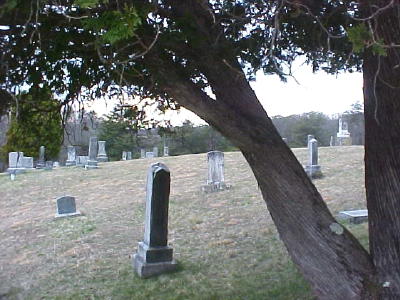
The Saunders Cemetery is located about one-half mile from Leading Creek, wherein is buried Collins, Haddox, Hayhurst, Metz, Rogers, Snider and the Saunders family, whose graves are unmarked, among many other settlers. The earliest burials are before the Civil War. Civil War soldiers buried there include Arthur and W. C. Wilson.
SHIMER/GAINER CEMETERY
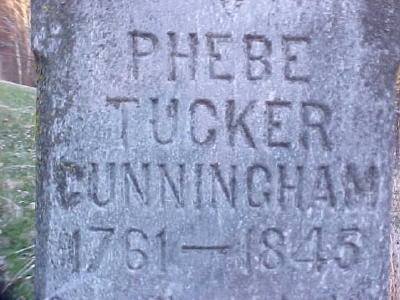
Just above the Leading Creek road on the hillside is where Phebe Cunningham (1761-1845) is buried beside the Shimer, Snider and Collins, including Issac Collins (grandson of Pheobe Cunningham) who died in 1833 and Issac (1792-1871) and Rachel (1794-1882) Collins.
FREED CEMETERY
Located about two miles down Leading Creek from Freed.
Mostly Freeds, with Henry Washington Freed among the earliest citizens. Other families include Snider, Mathess, Goodnight, Eckert, Ferrell, Bunner, Murphy, Collins, among many more. At least four Civil War soldiers buried there include Henry A. Ferrell, Joseph Jenkins, John W. Keebaugh and Hiram Boner.
We thank Patty Cain, Hazel Snider, Oleta Collins Cunningham Kelley and the residents of Leading Creek for their assistance with this article. - BW
TALES OF LEADING CREEK
LEADING CREEK YOUTH STRUCK DEAD BY LIGHTNING (1906) - Nineteen-year-old Ora Collins, son of Manley S. and Hannah Collins of Freed, was killed by lightning at their home of Archie Burrows on Pleasant Hill.
He and his sister, Miss Oda Collins (both of whom are school teachers) left their home to attend the Teacher's Institute, at Grantsville. "He seemed in the best of spirits all evening, laughing and chatting all the while. The family sat up rather late and although a terrible storm was raging without, happy and contented the inmates of that home little thought of the terrible scene they were to witness ere the light of another day."
"After putting away his coat and hat he removed his shoes."
He then requested the girls to sing "Guiding Star." He then turned to Mrs. Burrows and asked her to sing. "She sang, "When our waiting here is over, Jesus for us will come" and he joined in and helped her sing it."
"About five minutes later there came a terrific crash of thunder and lightning which struck the top of the flue, tearing it all to pieces, ripping apart the ceiling, striking the clock and tearing it all to pieces, blew panes of glass out of the windows, throwing all the inmates to the floor and tearing every pin out of their clothes, blew out the lamps, and left all in total darkness."
As soon as they began to recover from the shock they began to call each other's name. all answered "but Ora and he had gone to answer the roll call of Heaven."
"In a moment, in the twinkle of an eye, his precious life was snuffed out, and his spirit was wafted home to the God who gave it. How true are the words: "In the midst of life we are in death." And "be ye also prepared, for in the moment and hour when ye think not I will come again."
Everything that loving hands could do to bring him back to life, was done, but in vain.
1895 LAWSUIT GETS HEATED - "The law suit between Dr. I.C. White and R.F. Hickman, which has been attracting so much attention for some time was brought to a terminus before Squire Elliott, on Leading creek, last Tuesday night about midnight.
" "It was tried by a jury who found for defendant Hickman. The history of the case briefly told is about as follows: During the early days of May, last, forest fire got into and burned some fence for Dr. White."
"About the same time Hickman had fire in a clearing and the fire which burned White's fence came from the direction of Hickman's clearing, after which the Dr. and others made an examination of the premises, and believing he had sufficient evidence to prove that the fire did come from Hickman's clearing, suit was brought for damage."
"There were about thirty witnesses examined in the case and from the deportment of some of them it was apparent that some bitter feeling existed, and the bouts between Attorneys Ferrell for the plaintiff and Stevenson for the defendant, looked at times like there might be bloodshed, provided some one else would do the fighting."
"The Editor who was a disinterested spectator at the trial spent a pleasant day in the leafy grove, met a number of acquaintances and friends, secured several new subscribers, collected some money, enjoyed the hospitality of Wash Freed and his estimable lady, and last, but not least, ate the greater portion of a fine pike for dinner, which was duly appreciated."
"After the verdict of the jury, accompanied by J.T. Waldo and Attorney Stevenson, we hit the path for home, rounding into town between three and four o'clock a.m., feeling that we had been well paid for our journey." "We hope to meet the good people of Leading creek and vicinity, but we also hope it will be under more favorable circumstances or, at least, when they are not in a throes of excitement over a law suit between two neighbors."
CUNNINGHAM MONUMENT TO BE ERECTED: 1914 - The descendants of Phebe Tucker Cunningham, one of the most noted women of pioneer days, whose capture by the Indians is familiar to every reader of Indian warfare, will dedicate a monument to her memory on July 18, in the old Collins burying ground, at Freed, where she lies at rest.
Her husband Thomas Cunningham, sleeps at Frederick's Mills, in Ritchie county, on his old homestead, and a movement is on to mark his grave, also.
Few pioneers have a more interesting history or a longer line of descendants scattered throughout the state.
HOT AIR BALLOON SIGHTED ON LEADING CREEK: 1910 - Citizens of Brooksville and Freed Communities were startled Sunday afternoon by the appearance of a huge balloon soaring among the clouds over their heads.
Dr. Wright and other men who were on Leading Creek, got close enough to the balloon to converse with the occupants. The name of the balloon was the Miss Sophia, and the two occupants names were Afman and McCullough, both of St. Louis.
They had started in a race with another balloon from Indianapolis, Ind., Friday morning. They stopped for the night at Solmon Haullp's, near Lough. The balloon was from there shipped to McFarlan from whence it was shipped back home.
LEADING CREEK OIL BOOM: 1901 - Calhoun County is now the center of attraction to oil and gas men. Grantsville is crowded full of people with interest and the fever is high.
Among those fields are Leading and Yellow Creek.
An oil well on the Metz farm came in and is a good well, paying right handsome sums.
"As soon as the word got out that oil had been struck, oil men began to come here and at present the hotels are full of them, and more are arriving daily." "It is rumored here that the oil well being drilled on Bell Run of lower Leading Creek came in a strong producer. Up to the time of going to press, we have been unable to ascertain definitely as to the truth of this, but it seems to have come from a reliable source. It is said that the well is as good or better than the Metz well."
HOLLY GRIFFITH CROSSES LEADING CREEK: 1915 - "W.H. "Holly" Griffith, triple murderer who has caused so much excitement in this section of the country for the past two weeks, has probably given his pursuers the dodge and will remain at liberty until some future time."
"During the latter part of last week Griffith crossed over into this county from Ritchie followed by an armed posse of probably a hundred men with bloodhounds, making his way from Yellow Creek to Leading Creek, thence to the Little Creek country and on over into Roane county."
CUPID CAUSES TROUBLE ON LEADING CREEK: 1901 - "The course of true love never did run smoothly. George A. Monroe met, wooed and won a lady - Barbara Ellen Beall by name - the eldest daughter of Joshua Beall."
"So far, all was well. But alas Barbara Ellen was only fourteen years of age, two years under the statutory age for tasting hymeneial bliss."
"But that was not all. Stern Joshua objected to his daughter marrying the aforesaid George, had she been of lawful age. But love laughs at locksmiths, and other little difficulties, and the two happy lovers found a way out."
"She visited some of her relatives on Leading creek, and while there their plans were carried into execution."
"A certificate from the lady's parents to the clerk, granting their permission for the issuing of the proper permit and stating that Barbara Ellen was of marriageable age, was prepared, and somehow or other, stern Joshua's name appeared on it." "A minister was soon found who pronounced the mystic words which made them one, and they then tho't their happiness complete."
"But that is just where they were mistaken. Stern Joshua hearing of the doin's complained "upon oath etc." before 'Squire Marshall and a writ was issued commanding S.M. Scott, Constable, to forthwith arrest, etc., the body of the said George Monroe, which was accordingly done, and he was held in prison vile, while his young bride of a day wept in bitter anguish because of stern Joshua's hardness of heart.
"When the case was called, he waived examination, and readily gave the necessary bond which allowed him his freedom and the caresses of his fair Barbara Ellen." "And it is hoped that stern Joshua will relent and give to the unhappy couple his choicest blessing before their hopes are shattered by the stern process of the law."
OLD FREED SOLDIER GOES TO GRAVE: 1911 - "Another veteran of the Civil War answered the final roll call on Tuesday morning, October 3, 1911 at 11 o'clock, when the venerable George W. Shimer passed to his reward from his home at Freed after a long period of ill health which terminated in paralysis."
"Mr. Shimer has been a communicant of the U.B. Church since 1865 and was a highly respected citizen. He was born in Allegheny county, Maryland, on April 1, 1832, and there grew to manhood and was married on December 14, 1858 to Miss Rebecca Poling." "Immediately after casting his vote for Abraham Lincoln in 1860, set out, with his wife, for the wilds of West Virginia, and settled near White pine, in Calhoun county; and though he has resided at different points, he has ever since been a resident of county, more recently at Freed."
"He enlisted for the Union in 1861 in company C. of the 11th West Virginia Volunteers and followed the old flag for three years, and later in life joined the G.A.R."
"He is survived by eleven of his thirteen children: W.W., J.M., B.B., Okey, Mrs. Cordelia Simmers, Mrs. Lena Snyder, and Mrs. Ola Snyder, all of Calhoun county, Sherman, of Wirt county; James, of Pennsylvania, E.E. of Smithville, and Mrs. Mae Hays, of Hartley."
"There are forty-nine of his fifty eight grand-children and fourteen great grand-children also survive."
"The funeral took place on Wednesday afternoon at 1 o'clock from Hoy Chapel, at Freed, and was in charge of the U.B. Minister of Tannersville. Interment was made in the Gainer cemetery near one mile from Freed. The G.A.R. Post at Smithville had part in the services."
- Most of the tales are taken from transcriptions prepared by Norma Knotts Shaffer from early editions of the Calhoun Chronicle, but some material was from other sources.